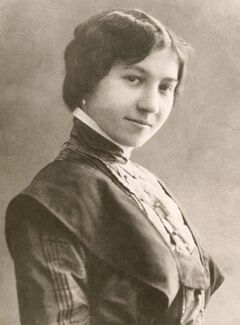More languages
More actions
Taisiya Zakharovna Solzhenitsyna Таисия Захаровна Солженицына | |
|---|---|
 Solzhenitsyna sometime in the 1910s | |
| Born | Taisiya Zakharovna Shcherbak 21 October 1894 Pyatigorsk, Terek Oblast, Russian Empire |
| Died | 17 January 1944 (aged 49) Georgievsk, Russian SFSR, Soviet Union |
| Cause of death | Tuberculosis |
| Nationality | Russian |
| Known for | being the mother of Russian writer Aleksandr Solzhenitsyn |
| Field of study | Agronomy |
Taisiya Zakharovna Solzhenitsyna (née Shcherbak; 21 October 1894 – 17 January 1944) was a Russian farmer and landholder, and the mother of Aleksandr Solzhenitsyn. She came from a well-off background, with her father Zakhar Fyodorovich Shcherbak owning a very rich and productive estate in Armavir, Kuban.[1]
Life[edit | edit source]
Taisiya Zakharovna Shcherbak was born on 21 October 1894 in Pyatigorsk. She was the daughter of Zakhar Fyodorovich Shcherbak, a wealthy Ukrainian landowner, and his wife Yevdokiya Grigorievna Shcherbak.
Taisiya spent much of her formative years at her father's estate. In 1908, Zakhar sent Taisiya to a private gymnasium in Rostov where she performed exceedingly well, learning how to speak three languages fluently and graduating with a gold medal.[2] She then enrolled at the Higher Women's Agricultural Courses in Moscow in 1912 where she studied agronomy; however, her studies were cut short due to the 1917 February Revolution.[2] While in Moscow she met Isaakiy Solzhenitsyn,[3] an officer in the Russian Imperial Army, whom she married in Byelorussia in August 1917.[4]
After the October Revolution, Taisiya and Isaakiy moved to Kislovodsk to live with her elder brother Roman, Roman's wife Irina, and Taisiya's parents (who had recently been forced to leave their estate as a consequence of the Civil War).[5] Isaakiy died only a few months later from a hunting accident in June 1918, and Taisiya was left to raise their soon-to-be-born son on her own.[6]
Aleksandr Solzhenitsyn was born in Kislovodsk on 11 December 1918.
In 1921, Taisiya moved back to Rostov in search of employment opportunities as she couldn't find any work in Kislovodsk; her son was left in the safekeeping of her sister Irina and her mother Yevdokiya.[7] Taisiya took great care to conceal her family origins, as word getting out that her husband was a Tsarist officer and her father a wealthy landowner could mean worse economic prospects for her. She hid photos of her husband, buried Isaakiy's medals, and during job interviews described her husband as just an "office worker" (служащи).[8] She eventually found a job as a stenographer, but was fired after her family background became known.[9]

From 1924 onwards, she lived with her son in a tiny, substandard, wooden shack in Rostov.[10] Aleksandr Solzhenitsyn left for V.M. Molotov Rostov State University in 1936.
In 1939, Taisiya and her son enrolled at the Moscow Institute of Philosophy, Literature and History (MIFLI).[11]
In 1941, Germany invaded the Soviet Union. Rostov was occupied by the Germans twice, first from November to December 1941, and again from July 1942 to February 1943. Taisiya was among those who were evacuated from the city, crossing the Don river by train and moving to Georgievsk in 1942 to live with her sister Maria along with Afanasy Karpushin, Maria's husband.[12] Georgievsk too was occupied by the Germans from August 1942 to January 1943. Taisiya returned to Rostov sometime after October 1942 only to find that the city had been completely decimated, and in 1943 she was forced to return to Georgievsk by her deteriorating health.[13]
Death[edit | edit source]
Taisiya Solzhenitsyna passed away from tuberculosis on 17 January 1944. She was 49. She was buried in Georgievsk Cemetery[14] in the same grave as her brother Roman (who died two weeks before she did) as her family couldn't afford to pay a gravedigger to dig Taisiya her own grave.[15]
In spring 2006, her grave was rediscovered, and a monument was built there in her memory.[14]
On 17 January 2007, Taisiya's grave was vandalised in what Russian police described as "an act of hooliganism."[14]
References[edit | edit source]
- ↑ Thomas, D. M. (1998).: Alexander Solzhenitsyn: A Century in His Life. New York. St. Martin's Press. p. 4, 5, 13, 22, 31, 32, 33, 34, 36, 57, 60, 61, 71, 305, 460, 474, 475.
- ↑ 2.0 2.1 Thomas, p. 10.
- ↑ Thomas, p. 12.
- ↑ Scammell, Michael (1984).: Solzhenitsyn: A Biography. W. W. Norton & Company. p. 30.
- ↑ Scammell, p. 32.
- ↑ Thomas, p. 25.
- ↑ Thomas, p. 34.
- ↑ Scammell, p. 47.
- ↑ Scammell, p. 48.
- ↑ Scammell, p. 47–48.
- ↑ Scammell, p. 95.
- ↑ Scammell, p. 118.
- ↑ Scammell, p. 120.
- ↑ 14.0 14.1 14.2 Sputnik International (2007-01-31).: "Suspect in desecration of Solzhenitsyn mother's grave detained".
- ↑ Scammell, p. 129.
